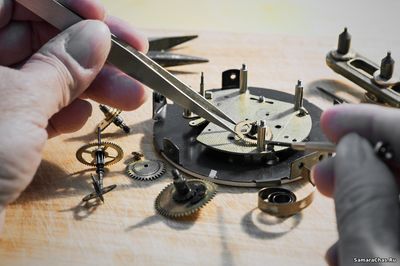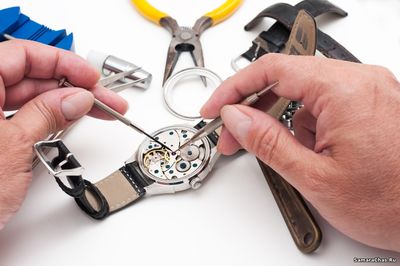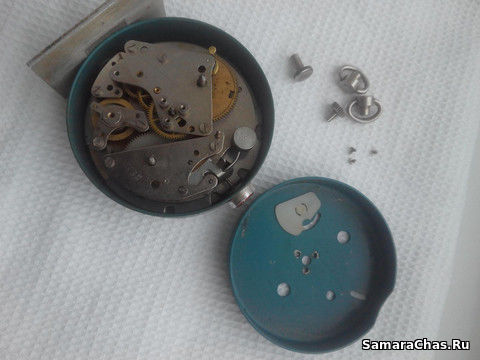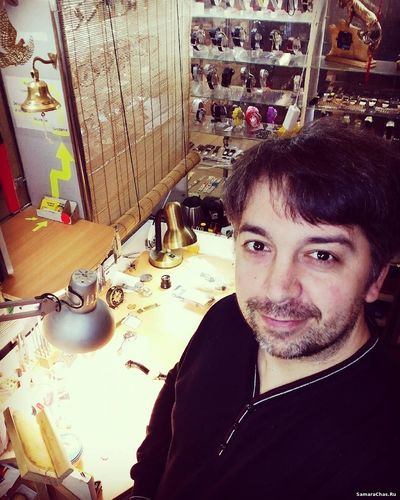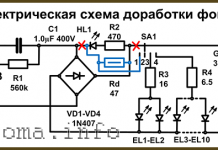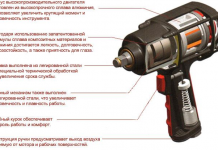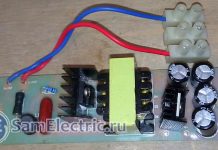In detail: do-it-yourself electronic clock repair from a real master for the site my.housecope.com.
Description of electronic clock repair Janus, made in the USSR. The basis of these watches is the K145IK1901 microcircuit - a common Soviet controller for building electronic clocks. The time is displayed on the large green display IVL1-7 / 5. Based on the experience and repair of such watches, it can be concluded that most often the quartz resonator fails, the electrolytic capacitors dry out, and the vacuum indicators fade away. Indicators that failed due to a burnout of the filament have not yet come across. Of course, it is best to repair any electronics with a circuit. Here are two similar schemes. If anything, the K145IK1901 and KR145IK1901 microcircuits are interchangeable during repairs.
- SB1 - “M” - setting the current time in minutes, in the “T” mode - in seconds;
- SB2 - “H” - setting the current time in hours, in the “T” mode - in minutes;
- SB3 - "К" - correction of the current time;
- SB4 - "C" - stopwatch mode;
- SB5 - “О” - stop indication;
- SB6 - “T” - timer mode;
- SB7 - “B1” - “alarm clock 1” mode, the time is set using the “H” and “M” buttons.
- SB8 - “B” - call the indication of the current time, for example, after setting alarms;
- SB9 - “B2” - “alarm clock 2” mode.
In this case, the watch lay idle for a long time and finally, after 5 years, it was needed. Initially, there was an idea to buy ready-made LEDs - with large numbers, 5-10 centimeters high. But after looking at the price for 1000 rubles, I realized that it was better to revive the old ones.
We disassemble the case and examine the circuit with details - everything is quite complicated, compared to modern ones, on microcontrollers and LCDs. The power supply seems to be simple - transformerless, but then a reduced voltage of 10 V is converted by a very cunning inverter on a multi-winding ring, into 27 volts of power supply for the anode of the IVL-1 indicator.
| Video (click to play). |
There are no signs of life, the fuse and diodes are normal, but the power supply to the filter capacitor (1000 microfarads 16 V) is only 4 volts.
We take a laboratory regulated power supply unit and supply the clock with the 10 V voltage set according to the scheme, controlling the current. Everything worked - the indicator lit up and the dot of seconds began to blink. The current was about 80 mA.
Obviously the problem is in the capacitor. And the culprit was not the electrolyte of the filter, as you might immediately think, but the ballast network, which has almost lost its capacity, at 400 V 1 microfarad. In parallel, a second similar one was soldered to it, and when it was connected to the 220 V network, the device worked. The voltage immediately rose to 10.4 V.
On this, the repair can be considered complete, and 1000 rubles already allocated for the purchase - saved. From this we conclude: do not be lazy to repair household appliances and electronics on your own, because in addition to saving money on buying a new one, you will feel joy from a job successfully done and pride in front of your household 🙂
Electronic watches are subdivided into two main designs. The first one is actually a mechanical watch with a spring motor and an electric winding; the second is an electronic clock, the source of energy for which is an electric battery or accumulator.
There is no motor in this watch, and the energy from the power source is used to directly actuate the governor.
Electrically wound watches have been around for decades; purely electronic watches, especially wrist watches, have appeared in recent decades. All of them are more high-precision than mechanical modifications and can operate continuously without changing the power source for a year or more.
Electromagnetic or magnetoelectric clock
According to the principle of operation, electronic clocks can be divided into contact, non-contact (transistor), synchronous, tuning fork, etc.
In a contact watch, the electric power supply circuit of the governor drive is closed by means of a contact. In contactless watches, a miniature transistor is used for the same purpose. The synchronous clock is driven by a synchronous electric motor. A tuning fork watch has a tiny tuning fork as a regulator, the vibrations of which set their mechanism in motion.
Currently, there are several dozen different types of contact clocks and almost the same number of transistor ones. There is no definite systematization of their designs.
Here are some of the more interesting options.
Electro-mechanical contact wrist watch
The principle of operation of this watch is based on the interaction of a permanent magnet and an electric coil. The impulse that drives the travel regulator in this watch is triggered by an electrical contact.
If in a mechanical watch, the movement of the hands is carried out due to the energy supplied from the mainspring through the engine, and the oscillatory system of balance - the spiral also consumes the energy of the spring to maintain the oscillatory process, while performing the functions of only a stroke regulator, then in an electronic-mechanical watch the balance system - spiral - an electromagnet performs two functions simultaneously: a regulator and a motor. Energy from the balance through the wheel system is transferred directly to the arrows. Thus, the kinematic diagram of a contact electronic-mechanical watch differs markedly from the kinematic diagram of a conventional mechanical watch.
The layout of the mechanism of an electronic mechanical watch is also different from the usual one. In most cases, electronic mechanical watches use balances that are much larger in diameter than balances in mechanical watches of the same size. This is because more balance has more momentum. The use of such a balance in electronic-mechanical watches improves the stability of the watch and greatly facilitates its operation.
The watch mechanism is assembled in three levels. At the top level is the balance, in the middle is the magnetic system, wheel gear and battery, and at the bottom is the switch mechanism. The balance axis passes through all three levels, which is specially lengthened. To protect it from possible shock damage, special shock absorbers are used, similar to the shockproof devices in mechanical watches.
The watch has a battery (battery). With one of its poles, the battery touches the current-collecting bus. Through this bus, the current flows into a column isolated from the rest of the watch mechanism, which carries a contact plate. This plate is threaded through a wire loop attached to a second plate, also insulated from the rest of the mechanism.
The other pole of the battery is in contact with the mass of the entire mechanism. In this direction, the current from the battery flows through the spiral to the balance, and from there - to the coil fixed in the slot of the balance rim. The coil is connected at one end to the balance itself. Keep in mind that all the electronic circuitry of a small watch is very small.
The balance has a contact pin to which the other end of the coil is connected. And under the balance is a permanent magnet of high power made of a special platinum-cobalt alloy. The electrical steel magnetic core creates the required concentration of the magnetic field in the path of the coil and reduces the dissipation of the magnetic field.
A roller is installed on the balance axis, in which an ellipse is fixed. As soon as the balance starts to move and begins to oscillate, the ellipse alternately grabs the ratchet teeth and rotates it.When the ratchet disengages from the ellipse, it is held in place by a magnet, also made of a platinum-cobalt alloy. The teeth of the steel ratchet are alternately attracted to the magnet, thus the ratchet is locked.
When the balance moves in the direction of travel, the ellipse grabs the next ratchet tooth and rotates it, as a result of which the next ratchet tooth is in a magnetic field. The magnetically tightened ratchet locks into position.
With the reverse movement of the balance, the ellipse does not remove the fixed tooth from the field of the magnet, since it displaces it only slightly. The ratchet is again attracted by the magnet and returns to its original position.
The ratchet wheel, in turn, meshes with the second center wheel. This wheel, when rotating, is mated with the minute wheel. A minute tribe is installed on the hub of the minute wheel. Through the bill wheel and its tribe, it is connected to the hour wheel.
The kinematics of the watch is as follows: if you put a battery in it and swing the balance, then the contact pin comes into contact with the plate and the electrical circuit is closed. The current flows through the coil, which will create an electromagnetic field around it. The moment the coil is close to the permanent magnet, the contact is triggered.
Due to the interaction of the electric fields of the coil and the magnet, a force will act on the coil to push the coil out of the magnetic field. The movement will cause the balance to rotate and begin to rotate. When the coil leaves the range of the magnet, the contact will be open and the impulse will cease to flow to the balance.
Under the influence of the spiral, the balance changes its direction of rotation. Because of this, the coil approaches the permanent magnet again. But no contact occurs as the contact pin goes past the end of the plate without touching it.
Some additional devices are required in a wrist electronic watch. The fact is that when you start the watch, you need to give the balance an initial impulse. A device in the form of a special system of levers is intended for this. At the same time, this device is intended to protect the balance from breakage when moving the arrows.
The system of levers slows down the balance when the turnover mechanism is activated.
Electronic-mechanical non-contact watches
This watch is also equipped with an electromagnetic balance drive, that is, a drive of the type in which an impulse is imparted to the balance due to the interaction of the fields of a permanent magnet and an electric coil (Fig. 7).
Rice. 7. Schematic diagram of the operation of an electronic-mechanical watch:
Where to begin. Some notes from Bogdan J.
This is purely the experience of an amateur who has never been a professional watchmaker. Accordingly, all this is suitable for the amateur. A professional is dear to the school. They will teach everything there.
Start with Pinkin. Or from Troyanovsky. In general, there are books on the topic of clock repair. Download and print. Okay, there is no Internet - everyone will do it for you in any Internet cafe. You must have a book. It can get expensive but well worth it. This book is a guide for the layperson who should be able to understand at least something from this book. Almost our case. I have never done anything like that - and here it was.
Let's make some additions with the amendment for today for those who are pinned.
Screwdrivers. Start simple.
Chinese. I use it. I sharpen it. As for Chinese screwdrivers - look where on the streets watch batteries are changed and batteries and watch straps are sold. Or in the most ordinary households. A set of screwdrivers for small jobs.
You take a screwdriver. If it turns out to be too soft and bends when trying to unscrew something, put a candle next to the screwdriver. You heat the blade of a screwdriver and quickly into wax. This is hardening. Then you take a small stone and sharpen it along Pinkin.
More cool - in a machine on a diamond disc. But it will be later. When the tool and machines appear.Stones are well suited for finishing.
Tweezers (for starters - medical eye tweezers will do).
An alternative is to get acquainted with a radio bazaar (if Moscow - it seems Gorbushka - where they sell radio components, radio stations and computer gadgets) - see the boxes where the instrument is sold. You will be greatly surprised by the abundance. Good tools are surprisingly expensive. Tweezers shapes - see Pinkin. I'm not talking about big watch shops. They would rather be beaten than sold at a normal price. They do not want to breed competitors. And if they do, the prices are simply unrealistic. Doesn't fit into any gate.
There is also a radio bazaar - Galosha gasoline. Wash. It is much drier than kerosene and white spirit.
You take sticks (like Chinese) - finger length - to taste. You stick fishing steel 3-4 cm long into the end - it can be thicker and thinner. 0.1 - 0.15 mm. This is for the fishermen. One meter is enough for 10 years of work.
The very tip with one blow of a hammer (through a punch or a hard piece of iron) is splashed on a hard anvil. You get a little spatula. You make 3-4 of these with different blade sizes and different steel diameters. This will replace butter dosing. As anvils, I use either a roller made of a large bearing or carbide plates for a lathe - your way to the flea market or to friends in the workshop.
In approximately the same way - they will come in handy for a start - sticks with ordinary sewing needles - while the hands are frightened and there are no good tweezers - to expose the details (gears in stones, screws, etc.) is an auxiliary tool.
Surgical clamps. Different. Very handy as small and strong pliers. They are usually bought on occasion at a flea market.
Dental spatulas. It is convenient to use in all cases as an auxiliary tool.
Enema. Rubber. From the pharmacy. Big. Blow off dust. The tip must be rubber.
Butter. Or in the workshop (if they don't beat you, although they usually look like rams and pretend that they don't understand what you are talking about at all and are trying to get you off as quickly as possible). Or maybe at a radio store - in the same place where solder and acid are sold. Oil MN-30, MN-45 or watch oil. Although it is not aerobatics, it will go for a start.
It is better to keep it in a dark heavy box - and the sun will not burn and there is less chance that it will turn over.
To open the cases - a large, broken medical tweezers. It is clear that this is not kosher - but it is also possible. Likewise - an old caliper. You just need to correct the edges of the jaws - so that they are more rectangular.
Scalpel - opening of enclosures.
Binocular loupe. It is relatively inexpensive, but without it it is better not even to start. Or photographic goods (classic - where telescopes and binoculars are sold) or a radio bazaar. There are different strengths. If you have money, take two. One is 1.5 times, one is the strongest one sold - it seems up to 2.5 times. They can be sold with an elastic band - you will have to redo them to fit a hard bezel. You can go and talk to the optics workshop - glasses. Maybe they will offer something like pince-nez. Regarding ordinary magnifiers - to my taste - I rarely use them. It turned out to be extremely useful for cutting off the baby's nails - they were not visible at all for the first six months, but it was necessary to cut them off.
Binocular - microscope. Yes. Old. Look. The oldest is MBS-1. It is with a straight image - not upside down - which is what we see. It should cost within $ 50. A very useful thing. In every way. Up to the point that you rip the scrap out of your finger. But this is on occasion and over time. MBS-10 or OGMZ is steeper - the distance from the object to the eyepiece is greater, it is clear that it is more expensive. But all the same, an ordinary screwdriver does not fit under the MBS-10 - it must be shortened. Although on the Site of the Lytkarinsky plant - the manufacturer of MBS-10, there is a link that they sell lenses for MBS-10 with a distance to the object - about 19 cm.This can be a good solution if we got MBS-10. Everything between MBS-1 and MBS-9 is the same. Over time, the lens can be altered by yourself.You take what is cheaper. It's closer to the flea market. The only thing is that it is desirable that there is an illuminator (transformer + light bulb).
All that is further from the instrument - only after evisceration for 4-5 hours.
Where to get a watch - make yourself a fashion to be at a flea market - everything floats there. Often they simply sell mechanisms there. For instance:
When you warm up a little - after buying a binocular microscope - there is also a radio bazaar, shops with tools - they usually sell ultrasonic cleaners. But here is also the question - is it necessary. 50 years before that they did not use them - they took a bath and washed the parts with a brush in gasoline. You can do it, but the weight is not bad. Should cost in the range of $ 50-80. Denatured alcohol and Galosha gasoline were poured into an ultrasound of 30 watts. Working. Does not flash. Washes like a beast, but all the same, sometimes you have to rip something off with a toothpick. At the bazaar, they say that 30-watt sinks - indestructible - work without problems and there is no return due to marriage. If the model is the same as in the figure - what should be done after purchase - disassemble completely (there may be moisture inside, one of the indicators is stylish clicks when working against a background of uniform sound), squeeze the metal tank out of the case and put it back on the Auto Sealant (white , ours, not on transparent silicone). Plumbing does not work - it is highly corrosive. One of the indicators of plumbing is a strong vinegar smell.
Yes, I forgot, a flea market - look for Petri dishes - or maybe in a pharmacy or in a laboratory at a hospital. But you are not their client - there is an expensive flea market - this is the very thing. These are flat round glass or plastic low trays - for details. They are cheap. Take 5 pieces for the current dismantling works. I like glass more - they are heavier, fidget less on the table.
Then, for convenience, in the offices that make business cards, you can sometimes roll up and buy boxes for business cards. Wholesale will cost within $ 0.30 pcs. Transparent ones are also a very convenient thing - but this is for longer storage.
Silica gel. Small bags that are put into new fashionable shoes, equipment, computer components. Absorbs water. It must be dried either in the microwave or at a good temperature - in an electric oven. Gas does not pass - when the gas burns, water is released. After drying, the bag is placed in a box in which small tools and spare parts are stored for a long time so that they do not rust.
Radio bazaar. Snap-on pouches - they sell in the hundreds. Size 4 X 6 cm. Place watches and small items. They are usually packed with small pieces that are sold in the bazaar.
To begin with, the wristwatch can be laid down on the grinder mesh during disassembly. Then you yourself will determine what you need and how it is more convenient for you. The stand can be machined out of brass. Should be heavy enough.
Take a coil from any old starter from electricians - try asking for 380 V. If not, by 220 V. You attach the wires - the demagnetizer is ready. Turn on only for a short time - it gets warm.
About a new instrument. It is not always worth the money. Think how to get out with what you have. It is needed if you make a living with this and the customer pays for everything. If this is a hobby, then not first of all. Calculate the costs like this: I quit smoking (and drinking) and all the savings are on the tool. In this case, it is really a hobby and a useful pastime.
Now the steepness has gone. Machine.
Option 2. High-speed car. 10,000 revolutions. We sharpen with a diamond file. It may well be. There are eagles who did something in this way. But as for me - this is not very correct. If sharpen then sharpen.
Considering the above - if you do not sharpen the axes how to fry pies - then for a non-professional watchmaker-turner, it would be more expedient to take a small-sized precision universal machine. I would say that 20% of the work is axle turning (or even less), 80% is the turning of screws and body parts, various secondary milling work.
Examples I would name the following:
Collet chuck, native collets. On top is a milling corner. A part of the caliper is attached to it and we get a "milling cutter".
- new - Proxxon PD-230 / E, including a milling attachment or FF-230 router. Search on There they even have a price list in the power tool section - that is, they really do it.
Regarding the old MD-65. Axes 0.1 sharpens. Doesn't hit. Any additional clarifications are superfluous.
Now for the next topic. Okay. We got a machine. Well kva. We have a type of computer in the form of a processor, monitor and keyboard. But all this locomotive also needs software. Windows-2000 or Windows-XP and for tough peppers Linux will do. So, the fun begins. Software often costs more than hardware. It's the same story with machine tools. We need fixtures and additional tools. I think that an approximate set of additional accessories for the machine will cost no less than the machine costs. We are now talking about turning + milling. I ended up with MD-65 with a milling angle plate - a milling cutter is clamped in the machine chuck, and the support is turned over like a milling table, only a vertical one + milling vise. The arrows on it are milled. Cut the slots in the screws too.
- incisors - at least a hundred. Fits well in old wooden school boxes.
For precise sharpened incisors, old boxes from under grandmother's silver spoons go very well - incisors are more expensive than spoons, they will not break.
- collets and collet chuck. I have 2 sets - one is native to MD-65 (3-13 mm), the second set is Lorsch (hour, 0-6 mm).
This is in the machine, Lorsch in the adapter.
- indicators. 0.01 and 0.001. It is clear that various attachments are needed for them. Often you have to do the fasteners yourself.
- center detectors - 0.01. Without it, there is simply nothing to do on the machine.
- binocular microscope. Without words. We have already talked about this above.
- 4-jaw chuck. With split jaw release.
- sharpener - sharpen the cutters roughly
- diamond wheels - sharpen cutters precisely
- rotary vise (horizontal rotary system) - drill holes in precisely specified places. Screw holes in the rim of the transparent case back. It is hand drilled. It can be seen that the screws are jumping.
- dividing head. Or with discs or vernier. Cutting gears. Or at least make a square.
- I'm not talking about cutters. And end and for gears. The thickness of the disc cutters - from 0.1-0.15 - is the thickness of the "Neva" blade.
- the measuring tool is for rough work
- and for precise ones - only optics
- then you need to look at what is needed already for the work being performed. You will have to do a lot yourself. To invent a lot. Very often, for the manufacture of one part, it takes more time to make a clamp in order to clamp this part into the machine.
Foil trimming - making a "disk" arrow. Materials at hand.
Now the conversation is where and how to organize all this. It should be dry. Dust free. Not on the head of the family - the family should know that it is yours - and no matter what you do there - they have no entrance there. And there is nothing to howl about the noise from the workshop. Their comments are inappropriate (oh, it's dirty, oh, it stinks with gasoline).
One type I saw a German machine - the type of our school. More precisely, only pre-war. He mounted it under the kitchen table. In the center of the table is a shelf with a machine on it. The top board of the table rises - like in old school desks. He lowered the board, put the tablecloth in place and crumble the onion with the sausage. All the same, there will be no big turning works at home - everything is some kind of small piece.
If the conversation is about a large workshop or a more serious occupation in the restoration business for the soul, then in addition to the small machine, you need to look towards the larger machine - a school one (I don’t want to name the type - there are many different ones), a horizontal milling NGF-110 and a muffle furnace - this is for more rough work and the manufacture of devices. It is clear that all this also needs a trailer of devices and tools. Photo of the basement in the country.
If you can order or buy somewhere, look towards the rollers. They can be quite expensive. Sometimes they help out a lot. Especially in the manufacture of new parts, arrows and shims for lathe cutters.
As a conclusion, let's put it this way - this process is endless. In one sensible book on choosing a watch lathe, there was a good idea, completely applicable in our case - we are all mortal. All these tools are of interest only to us. Personally. There is no need to expect that someone after us will continue with fire in their eyes what we have begun. The whole instrument must be bought on the basis that after us, our grateful descendants die of all this rubbish and faster. They can also be thrown into the trash. They need a place for a geranium! We need to make sure that they can get more for it, slowly and confidently to all these numerous relatives and posterity, it is necessary to explain that all this is expensive and on this in distant times it will be possible to earn something. And accordingly, if you already buy, then buy a liquid instrument, which will have a price even in 50 years. This is on the one hand. On the other hand, we are all working now. We earn something. This is exactly the right time to prepare for yourself a range of activities for a time when our earnings will decrease, that is, retirement. Good luck.
Why can't a person find the videos they want on Youtube? The thing is that a person cannot come up with something new and look for it. He was out of fantasy. He has already watched a lot of various channels, and he no longer wants to watch anything (from what he watched earlier), but what to do in this situation?
In order to find a Youtube video that suits your needs, it is imperative to keep searching. The harder your search is, the better your search result will be.
Remember that you only need to find a few channels (interesting), and you can watch them for a whole week or even a month. Therefore, in the absence of imagination and unwillingness to search, you can ask your friends and acquaintances what they are looking at on Youtube. Perhaps they will suggest original vloggers that they like. You, too, may like them, and you will become their subscriber!
Online mp3 cutting is convenient
and a simple service to help you
create a musical ringtone yourself.
YouTube video converter Our online video
the converter allows you to download videos from
YouTube website in webm, mp4, 3gpp, flv, mp3 formats.
These are radio stations to choose from by country, style
and quality. Radio stations all over the world
over 1000 popular radio stations.
Live broadcast from webcams is made
absolutely free in real
time - broadcast online.
Our Online Television is more than 300 popular
TV channels to choose from, by country
and genres. Broadcasting of TV channels is free.
A great opportunity to start a new relationship
with a continuation in real life. Random video
chat (chat roulette), the audience is people from all over the world.
But is it worth the rush? Perhaps this watch can still be repaired.
If you are a beginner and have never dealt with the repair of a watch movement before, then you should familiarize yourself with a few rules that any watchmaker adheres to.
1. The clockwork is the most complex "organism" in which all its elements work as a single whole. Therefore, watch repair must be careful and careful. You must understand how they work, because some parts of the watch mechanism are so small that it will not be difficult to damage them.
2. Remember that proper specialized tools are required to gently remove the machine components. Otherwise, your repair will lead to an inversely proportional result.
It is also worth noting that even if in some miraculous way these tools are at your fingertips, but you do not have the slightest idea about the mechanism of the watch, they will not help you. If you are not confident in your abilities and do not have sufficient experience, it is better to give your watch to the workshop. They will be properly repaired by professionals in their field.
3. Watch mechanisms from the times of the Soviet Union are not inferior to their more eminent and expensive counterparts from Switzerland in terms of the complexity of repair.
4. Like most other movements, the watch needs lubrication. They won't work without it. Remember that by the word lubricant we mean a specialized substance designed specifically for watch movements, and not petroleum jelly or, even better, sunflower oil. The last two options are not even suitable as a temporary solution to the problem. The lubricant should be applied to the parts of the mechanism that require it, with exact observance of the quantitative proportions of the substance. If you think that the watchmaker, when carrying out repairs, abundantly waters the entire mechanism from a huge oiler, then you are greatly mistaken.
5. If for some reason you still do not want to give your watch to a professional workshop and cannot get rid of the desire to carry out the appropriate repairs yourself by purchasing specialized tools, you should know that a watch set for 600 rubles, which can be bought on most Internet stores won't be enough. This is a waste of money. A high-quality watch tool is expensive, and purchasing it for a one-time repair is not the most rational act.
6. Before starting work, read the relevant literature. For a beginner, we recommend the book "Construction and assembly technology of mechanical watches" by S.М. Tagirova. It is distinguished by the clarity and utmost brevity of the material presented in it. After reading it, most of your questions will be answered. Agree, there is nothing worse than a beginner who does not even understand the basics of the business that he decided to take on, and even showered you with constant questions: "what, but how?".
7. Remember - do not touch the components of the clockwork with your hands. For these purposes, you must use tweezers, gloves, fingertips or, at worst, a toothpick.
8. Are you going to make watch repair your hobby? Be prepared for high financial costs.
Entry-level watch tools, designed primarily for assembling watches, cost about ten thousand rubles, for minimal repairs - from one hundred thousand. In any case, you won't be able to buy everything at once. Assembling a complete set of tools can take a lifetime. The same rule applies to repair training.
Patience is an essential character trait of any watchmaker. Without him, in this case, nowhere. First of all, you should honestly answer to yourself one simple question: "Do you need all this?"
Let's assume that you have nevertheless acquired the necessary tools and equipped your workspace. Where to begin? Do not know? We will give you a hint.
Determine the breakdown or malfunction of the clock mechanism, which led to its malfunctioning or stopping. In 80% of cases, this is dirt and dried grease on the parts of the mechanism. This kind of malfunction of the mechanism can be determined by eye. Their main features are black tribes and dried oilers. The solution to this problem is to disassemble the clockwork, clean all its parts from dirt and lubricate.
Remember the patience we described above? Well, it is at such moments that you need it. Haste is your greatest enemy.
The most important part of this craft that you will need to learn is the disassembly and assembly of the watch mechanism. An old, irreparable watch is suitable for training - this is the best option. You are not immune from mistakes, like any other person, and with such training they cannot be avoided.We consider the Slava alarm clock to be the most optimal option for learning. Its movement is similar to most mechanical wristwatches, and the details are not so small.
Let's look at it using the example of the above-mentioned alarm clock.
The first is to remove the back cover. Unscrew the factory keys, remove the buttons for shifting the hour hands, and then unscrew the fastening screws. In wristwatches, the back cover of the watch can be attached to their case, either with screws or with the help of special latches.
The second is to remove the mechanism. Look carefully and study the method by which the fastener was carried out. Unscrew the fixing screws. If you have a wristwatch in your hands, before removing the mechanism, take out the winding shaft, putting it in the eyeliner mode, and slightly press down on the suppressor, then take it out. At the end of the procedure for removing the mechanism, the winding shaft must be reinstalled.
The third is to remove the hands and dial. The first ones are removed quite easily - you just need to pry them slightly. To do this, use corners (tweezers, nippers). Thanks to this tool, you can avoid the appearance of mechanical damage (scratches, microcracks), both on the hands and on the dial. In cases where the watch model that you are repairing is not equipped with a calendar or chiming, it is possible to remove the dial, hour wheel and hands as a whole. Loosen all fixing screws carefully. In most cases, they are located on the front side of the mechanism opposite each other. All actions related to disassembly and assembly must be performed on a specialized stand that prevents dust from entering your workspace from the rest of the surface on which the stand is installed.
The fourth is the release of the spring. We apologize for the professional slang. Descent is a weakening of the spring winding. Take a pair of tweezers in your hand, the other - wind the spring by half a turn and in this state, use tweezers to move the dog. After that, slowly, without sudden movements, begin to release the winding shaft and wait for the moment when the spring is fully unwound.
Fifth - removing the balance bridge. Unscrew the fixing screws. Next, pry the bridge with tweezers and carefully, lifting it together with the balance, remove it from the clockwork. Be careful. Do not allow the balance spring to cling to the wheels. Remember that if you put the bridge down with a balance, you can damage the axle. Don't let this happen.
Sixth - removal of the anchor fork bridge. Unscrew the fixing screws. Next, remove the bridge, and then remove the plug itself.
Seventh - removing the spring bridge. This operation is performed in a similar way to the sixth stage.
Eighth - removal of the axle of the wheel system. First, remove the minute tribe located on the center wheel. If you practice with the alarm clock, which we talked about just above, then you do not need to shoot the minute trib. In addition, it is worth noting that in the mechanism of this alarm clock, the axles of the wheel system and the springs are one whole. After you unscrew the mounting screws and remove the axle, take out the wheels. Take your time and take out the wheels one at a time - this will allow you to avoid damaging adjacent wheels.
That's all. You have disassembled your first movement. However, it still needs to be collected. To do this, follow all the same steps in reverse order.
The first time is the most difficult. Therefore, we advise you not to try to piece everything together from memory. This will come later - with experience. It is best to run your eyes through the sequence described by us, only in reverse order and, only after that, perform the appropriate action. This way you can quickly and efficiently assemble your first movement, which has just been safely disassembled.
Good luck in your endeavors!
After writing this article, we have a new one, we invite you to get acquainted:
How to repair a mechanical wristwatch yourself. Instructions for beginners.
Write, call and come by contact information,
posted here (link CONTACTS AIRCRAFT shopping center)
We kindly ask you to pay attention that our workshop is located in Samara.
We hope that after reading this article, you have discovered something new and interesting for yourself.
And remember, if you are the owner of one of the watches that we talk about on our website and feel that they need repairs or maintenance, or you just want to get professional advice from highly qualified watchmakers in the city of Samara, feel free to contact us.
Our experts will help you
to repair the following types of watches for you:
- old mechanical (the possibility of repair is determined by the master at the time of inspection);
- wall-mounted (the possibility of repair is determined by the master at the time of inspection);
- floor;
- desktop;
- Pocket;
- wrist;
- and even electronic-mechanical and quartz.
We will be sincerely glad for all your thoughts that you leave in the comments under this article.
I liked it very much!








Awful book!

If the number of striking strikes does not correspond to the actual readings of the clock hands, remove the striking weight and put the hour hand on the number on the dial of the number of striking strikes. Then hang the fighting weight back and set the hour and minute hands to the present time.
If the discrepancy still cannot be corrected, it means that the clearance of the counting lever in the slots of the counting circle has not been adjusted. It can be adjusted by bending the legs of the counter lever. To do this, you do not need to disassemble the watch mechanism: just open the back wall of the case and check where the fight gets lost in the counting circle, and bend the nose of the engaging lever in the desired direction.
If you find that the pins of the minute wheel are bent or fall out, you need to do the following. Remove the arrows and, having removed the hook, open the cuckoo door. Then unscrew and remove the chassis panel. Hang the weight of the fight and observe the operation of the mechanism.
Remove the minute wheel and bushing. The bent pins of the minute wheel can be straightened in place, and loose or loose pins are reattached and secured.
Chapter 2. Repair of electronic watches
Electronic watches are subdivided into two main designs. The first one is actually a mechanical watch with a spring motor and an electric winding; the second is an electronic clock, the source of energy for which is an electric battery or accumulator.
There is no motor in this watch, and the energy from the power source is used to directly actuate the governor.
Electrically wound watches have been around for decades; purely electronic watches, especially wrist watches, have appeared in recent decades. All of them are more high-precision than mechanical modifications and can operate continuously without changing the power source for a year or more.
According to the principle of operation, electronic clocks can be divided into contact, non-contact (transistor), synchronous, tuning fork, etc.
In a contact watch, the electric power supply circuit of the governor drive is closed by means of a contact. In contactless watches, a miniature transistor is used for the same purpose. The synchronous clock is driven by a synchronous electric motor. A tuning fork watch has a tiny tuning fork as a regulator, the vibrations of which set their mechanism in motion.
Currently, there are several dozen different types of contact clocks and almost the same number of transistor ones. There is no definite systematization of their designs.
Here are some of the more interesting options.
The principle of operation of this watch is based on the interaction of a permanent magnet and an electric coil. The impulse that drives the travel regulator in this watch is triggered by an electrical contact.
If in a mechanical watch, the movement of the hands is carried out due to the energy supplied from the mainspring through the engine, and the oscillatory system of balance - the spiral also consumes the energy of the spring to maintain the oscillatory process, while performing the functions of only a stroke regulator, then in an electronic-mechanical watch the balance system - spiral - an electromagnet performs two functions simultaneously: a regulator and a motor. Energy from the balance through the wheel system is transferred directly to the arrows. Thus, the kinematic diagram of a contact electronic-mechanical watch differs markedly from the kinematic diagram of a conventional mechanical watch.
The layout of the mechanism of an electronic mechanical watch is also different from the usual one. In most cases, electronic mechanical watches use balances that are much larger in diameter than balances in mechanical watches of the same size. This is because more balance has more momentum. The use of such a balance in electronic-mechanical watches improves the stability of the watch and greatly facilitates its operation.
| Video (click to play). |
The watch mechanism is assembled in three levels. At the top level is the balance, in the middle is the magnetic system, wheel gear and battery, and at the bottom is the switch mechanism. The balance axis passes through all three levels, which is specially lengthened. To protect it from possible shock damage, special shock absorbers are used, similar to the shockproof devices in mechanical watches.


